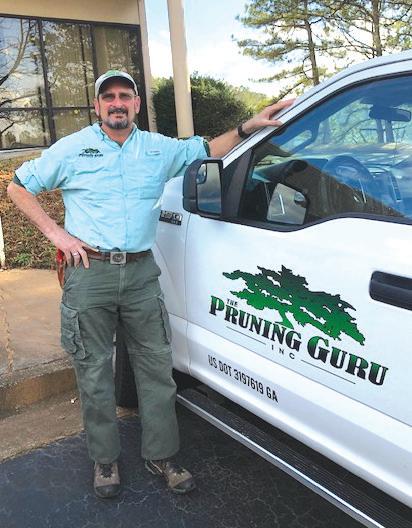PEST 411
Ornamental nurseries beware
Watch out for the redheaded flea beetle by Shimat V. Joseph, Department of Entomology, University of Georgia
species. Females are slightly larger than males. A pair of light-brown serrate antennae originates below the eyes, with dark-brown distal segments. On the last pair of legs, the femur is wider and swollen, which enables RHFBs to jump. Mature females lay pale-yellow eggs singly in the potting medium. Larvae are about 0.5 to 1 cm in length and are creamy-white in color (Fig. 2), with the head capsule and three pairs of legs pale-brown in color. The last segment on the rear end of the larva is oriented upward with prominent setae (hairs) (Fig. 2). They undergo three larval stages, which all feed on roots.
The adult RHFB causes serious feeding damage to the foliage of a variety of woody and herbaceous container plants in nurseries. As the name suggests, RHFB jumps when disturbed, similar to a dog flea.
UAC MAGAZINE | SUMMER 2020
The redheaded flea beetle (RHFB), Systena
12
frontalis (F.) (Coleoptera: Chrysomelidae) (Fig. 1) is a serious insect pest in ornamental nurseries. It is also referred to as cranberry flea beetle in cranberry and blueberry systems in the northern US. The adult RHFB causes serious feeding damage to the foliage of a variety of woody and herbaceous container plants in nurseries (Figs. 3 and 4). As the name suggests, RHFB jumps when disturbed, similar to a dog flea. RHFB is native to the US and is present in the central and eastern US.
Identification and biology RHFB adults are small, shiny, oval-shaped beetles, about 0.2 inches in length, with metallicblack colored bodies and the red-colored head, which is a unique identifying character that distinguishes these beetles from other similar
RHFB overwinters as eggs. In nurseries, adult beetles are first observed feeding on foliage typically during the last week of May in most of Georgia, although this could be subject to local weather conditions. After a distinct firstgeneration emergence in the spring, multiple overlapping generations occur in Georgia until late October. During summer, multiple stages (eggs, larvae, and adults) may be found on an individual containerized plant.
Host plants RHFB feed and cause damage to numerous plants grown in the nursery industry. In Georgia, high numbers of RHFB have been found on hydrangeas [panicle hydrangea (Hydrangea paniculata) and roses (Rosa spp.). In addition, RHFB damage has been reported on Virginia sweetspire (Itea virginica), forsythia (Forsythia x intermedia), anise-tree (Illicium spp.), azalea (Rhododendron spp.), crapemyrtle (Lagerstroemia spp.), dogwoods (Cornus spp.), Japanese holly (Ilex crenata), weigela (Weigela florida), loropetalum (Loropetalum sinense), fragrant osmanthus (Osmanthus fragrans), viburnum


















